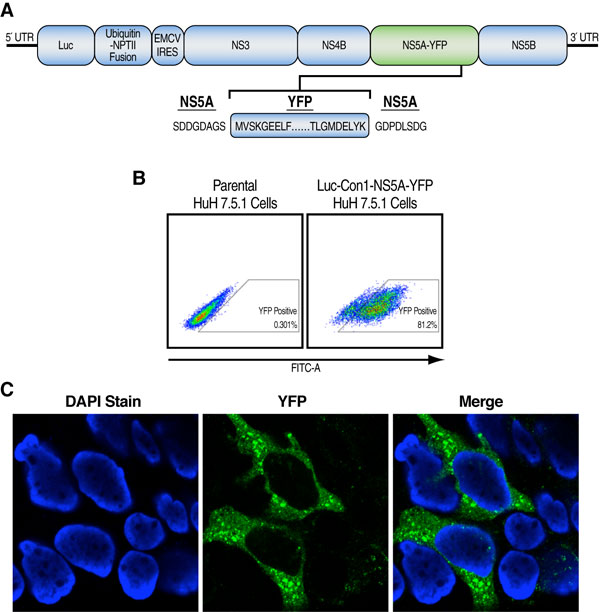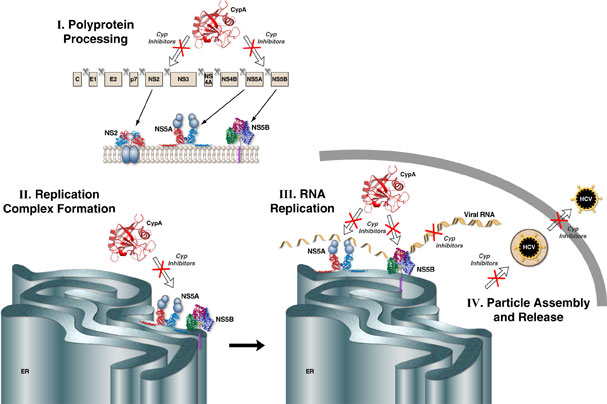The Gallay Laboratory
Projects
| Click here for Human Immunodeficiency Virus (HIV) Project Understanding the Role of Cyclophilins in HCV Replication and the Mechanisms of Action of Cyclophilin Inhibitors
Cyclophilin inhibitors (CypI) have demonstrated great potential for the treatment of HCV patients as IFN-free regimens. Despite intense academic and pharmaceutical research, their mechanisms of antiviral action remain poorly understood. We and others demonstrated that the host peptidyl-prolyl isomerase protein - cyclophilin A (CypA) - is absolutely necessary for HCV replication and represents the prime intracellular target for CypI. We also obtained several lines of evidence that the HCV protein NS5A serves as the main viral ligand for CypA. Importantly, we found that CypI block both NS5A-CypA contacts and HCV replication. Thus, there is a direct correlation between preventing NS5A-CypA interactions and inhibiting HCV replication. One of our current hypotheses of work for CypA action is that CypA via its isomerase activity establishes the proper folding of NS5A. One attractive possibility is that CypA regulates the formation of a functional HCV RNA complex (RC). In this model, CypA, by interacting with NS5A, dictates the optimal composition of the HCV RNA complex in specific viral and host components, which are absolutely required for HCV RNA synthesis (Model 1). Our recent work suggests an additional or alternate role for CypA. Indeed, we found that CypI exert no inhibitory effect when added to isolated HCV RCs, suggesting that CypA inhibition does not affect HCV RNA replication after RC formation. We thus postulated that CypA plays a role earlier in HCV replication, such as on the formation of mini-organelles facilitating RNA replication. Supporting this hypothesis, we found by electron microscopy (EM) that HCV-infected, but not uninfected cells contain high numbers of double membrane vesicles (DMVs). Importantly, we found that CypI prevent the formation HCV- as well as NS5A-mediated DMVS formation. This not only suggests that NS5A is a critical factor for DMVS formation, but also that NS5A-CypA interactions play an early role in the formation of functional RC such as the creation of a protective membrane compartment necessary for genome replication and protection from cellular defense mechanisms. This is our second hypothesis of work for the role of CypA (Model 2). The two proposed models are not mutually exclusive since CypA may play consecutive and distinct roles in the establishment of an enzymatically functional HCV RNA complex. Our major goals in the laboratory are to understand i) what is the true action(s) of CypA on NS5A; ii) at which stages of the virus cycle NS5A-CypA interactions play critical roles; iii) whether CypA plays one or multiple roles in HCV replication; iv) what are the role(s) of CypA in HCV replication; and v) how mechanistically NS5A-CypA interactions govern HCV replication. These studies should not only provide new tools to fight this prime threat to humans – HCV – but also should shed light on the cellular function of CypA.  Figure 5: NS5A-CypA Interaction Detected by FRET.Remarkably, Cyp inhibitors prevent the CypA-NS5A interaction in a dose-dependent manner. The CypA-NS5A interaction is conserved among genotypes and is interrupted by Cyp inhibitors. Moreover, CypA, devoid of its isomerase activity, fails to bind NS5A. Altogether our data suggest that CypA, via its isomerase pocket, binds directly to NS5A, and most importantly, that disrupting this interaction stops HCV replication. Figure 5: NS5A-CypA Interaction Detected by FRET.Remarkably, Cyp inhibitors prevent the CypA-NS5A interaction in a dose-dependent manner. The CypA-NS5A interaction is conserved among genotypes and is interrupted by Cyp inhibitors. Moreover, CypA, devoid of its isomerase activity, fails to bind NS5A. Altogether our data suggest that CypA, via its isomerase pocket, binds directly to NS5A, and most importantly, that disrupting this interaction stops HCV replication. Figure 6: Model for the mechanisms of action of Cyp inhibitors. Several models have been proposed to explain how Cyp inhibitors block HCV replication. Inhibiting HCV polyprotein processing: C-terminal NS5A mutations, which confer Cyp inhibitor resistance, slow down the processing of JFH-1 polyprotein precursor. In this model, CypA neutralization by Cyp inhibitors would interfere with RC formation (Model I). It remains to be demonstrated that CypA affects the processing of polyproteins of other genotypes. Preventing CypA recruitment into RC: CypA locates in a protease-resistant compartment similar to that where HCV replicates. Since CsA blocks CypA association with this compartment, one can postulate that Cyp inhibitors deplete RC of CypA, leading to abortive RC. If this model is correct (Model II), it would suggest that HCV exploits a protected compartment enriched with CypA to initiate RC formation. Interfering with NS5B polymerase activity: Because CypA binds NS5B, one could postulate that CypA enhances both NS5B affinity to viral RNA and HCV replication. Supporting this model, CsA resistance is associated with NS5B mutations, which increase NS5B binding to viral RNA in the presence of CsA. In this model (Model III), Cyp inhibitors, by preventing the contact between CypA and NS5B, would weaken NS5B binding to viral RNA, leading to abortive RC. Neutralizing NS5A activities: CypA-NS5A interactions could regulate several steps of the HCV life cycle. Since NS5A binds both NS5B and viral RNA, CypA neutralization by Cyp inhibitors could hamper HCV RNA replication (Model III). In this model, NS5A mutations in Cyp inhibitor-resistant variants would preserve the contact between NS5A and NS5B or the viral RNA. The interplay between CypA, NS5A and NS5B remains to be examined at a molecular level. Since NS5A also plays an essential role in HCV assembly, one could envision that CypA neutralization by Cyp inhibitors could also interfere with particle release (Model IV). Neutralizing NS2 activities: NS2 contributes to RNA replication by cleaving off itself from NS3. NS2 has been implicated in both modulation of host cell gene expression and apoptosis. One could envision that CypA-NS2 contacts trigger the proper folding of NS2 and enhance NS2 activities. In this model, CypA neutralization by Cyp inhibitors, would interfere with NS2 functions (i.e., polyprotein processing) (Model I). Figure 6: Model for the mechanisms of action of Cyp inhibitors. Several models have been proposed to explain how Cyp inhibitors block HCV replication. Inhibiting HCV polyprotein processing: C-terminal NS5A mutations, which confer Cyp inhibitor resistance, slow down the processing of JFH-1 polyprotein precursor. In this model, CypA neutralization by Cyp inhibitors would interfere with RC formation (Model I). It remains to be demonstrated that CypA affects the processing of polyproteins of other genotypes. Preventing CypA recruitment into RC: CypA locates in a protease-resistant compartment similar to that where HCV replicates. Since CsA blocks CypA association with this compartment, one can postulate that Cyp inhibitors deplete RC of CypA, leading to abortive RC. If this model is correct (Model II), it would suggest that HCV exploits a protected compartment enriched with CypA to initiate RC formation. Interfering with NS5B polymerase activity: Because CypA binds NS5B, one could postulate that CypA enhances both NS5B affinity to viral RNA and HCV replication. Supporting this model, CsA resistance is associated with NS5B mutations, which increase NS5B binding to viral RNA in the presence of CsA. In this model (Model III), Cyp inhibitors, by preventing the contact between CypA and NS5B, would weaken NS5B binding to viral RNA, leading to abortive RC. Neutralizing NS5A activities: CypA-NS5A interactions could regulate several steps of the HCV life cycle. Since NS5A binds both NS5B and viral RNA, CypA neutralization by Cyp inhibitors could hamper HCV RNA replication (Model III). In this model, NS5A mutations in Cyp inhibitor-resistant variants would preserve the contact between NS5A and NS5B or the viral RNA. The interplay between CypA, NS5A and NS5B remains to be examined at a molecular level. Since NS5A also plays an essential role in HCV assembly, one could envision that CypA neutralization by Cyp inhibitors could also interfere with particle release (Model IV). Neutralizing NS2 activities: NS2 contributes to RNA replication by cleaving off itself from NS3. NS2 has been implicated in both modulation of host cell gene expression and apoptosis. One could envision that CypA-NS2 contacts trigger the proper folding of NS2 and enhance NS2 activities. In this model, CypA neutralization by Cyp inhibitors, would interfere with NS2 functions (i.e., polyprotein processing) (Model I).Nevertheless, the molecular requirements for CypA in HCV replication and how NS5A-CypA interactions govern HCV replication remain to be understood. It is important to emphasize that very recent findings suggest that the NS5B polymerase as well as NS2 could represent additional indirect ligands for CypA. Therefore, at this stage one cannot exclude the possibility that Cyp inhibitors block HCV replication by interfering with several steps of the HCV replication cycle as suggested in the model below (Figure 6). A main goal in the laboratory is to understand why HCV exploits CypA to replicate in humans, to understand at a molecular level how CypA assist HCV, and to unravel the mechanisms of action of this novel class of promising anti-HCV agents - the Cyps inhibitors. These studies should not only provide new tools to fight this prime threat to humans – HCV – but also shed light on our understanding of the true cellular functions of Cyps.
|

